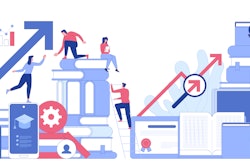
Supply chains are changing by the second, as technological advancements and dynamic disruptions are revolutionizing and optimizing management practices.
Things like AI and machine learning are enabling predictive analytics, helping companies forecast demand more accurately and manage inventory more efficiently. Blockchain tech now offers enhanced transparency and traceability.
And of course, the rise of e-commerce is ongoing, as the shift towards omnichannel retailing demands more agile and responsive supply chain networks. All of these topics were threaded together in various conversations during Supply & Demand Chain Executive and Food Logistics' SCN Summit series in June. From the state of the industry to workplace culture, every corner of operations was covered, and outlooks proposed for 2025.
Knut Alicke, partner at McKinsey & Company, explains the top 3 major issues faced in supply chains right now include disruption, the labor force and tech implementation. Alicke describes the later as "the AI effect", where a new wave of operations has taken shape utilizing things like generative AI for communications automation, document creation, insights and planning.
Speaking of generative AI, Barry Kukkuk, co-founder and chief technology officer at Netstock, and Jefferson Barr, chief marketing officer at Netstock, together discussed the topic and its impact on demand planning. As Kukkuk explains, the transformation of AI has been a long time coming but hasn't expanded into mainstream until recently with the introduction of platforms like ChatGPT. Today, he says, the limitations and strengths of AI are just now coming into reality for businesses and individuals learning to use it in a productive way.
Company culture can shape a workforce— in a post-covid world we know this to be true more than ever. Mitch Luciano, CEO at Trailer Bridge, says that its more than "drinking the Kool-Aid". He explains that when times are good everyone loves working within the culture of a company because there's celebration and connection, but over the past few years, specifically in transportation, times haven't been good and when things turn south is when company often forget about the core of who they are and lose the path of what they're committed to.
"They start making drastic changes that they think will improve things and magically they don't," says Luciano. "Do the things that got you where you were, you might have to make tweaks so the company can stay afloat in challenging times, but it doesn't mean you can't be kind and believe in the core principle of being accountable to each other, respecting each other and showing integrity."
When it comes to the action of transportation in supply chain, challenges remain. Avery Vise, vice president of trucking at FTR, explains the biggest issues affecting the freight market today is capacity utilization. Back in 2021, Vise says, capacity utilization was at 100% but due to a weakening of freight demand and steady gains in the truck driver population, that number began to fall sharply in 2022 and bottomed out at the beginning of last year. Although there has been an upturn in the past few months it hasn't been significant enough to warrant much change in percentages. "The utilization is key because it's what keeps logistics costs low for shippers and freight rates relatively low for carriers. The environment will really only change once that utilization picture changes, which probably isn't going to be until early next year, and maybe even later, until that change is significant enough to move the market," says Vise.
Watch all the SCN Summit sessions on-demand here.
The pandemic exposed vulnerabilities in global supply chains and 4 years later we are still seeing the affects. At this point, industry changes are permanent, but with these influences has come great opportunities for optimizing operations with the use of new tools and new perspective. Without a crystal ball, the best way to solidify operations might be to reflect on previous practices and merge the best qualities with the technologies available to keep up with the market, demands and expectations of tomorrow.




















